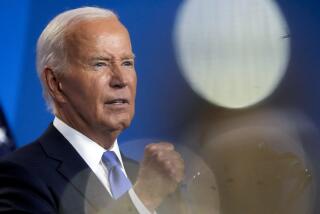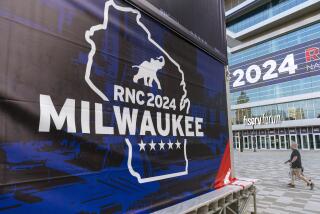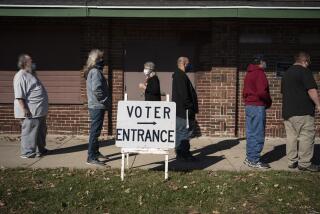GOP Uses Secret Ballot; Democrats Take Public Stand : Iowa Caucuses: Study in Party Contrasts
- Share via
DES MOINES — Both Democrats and Republicans vote in Iowa’s caucuses Feb. 8. But the process for each party is so utterly different, you would hardly know you are in the same state.
For Democrats, the atmosphere will be open and boisterous--like a prize fight or the closing hour on the floor of the stock exchange. Here you vote with your feet, walking to a corner of the room and standing in public in groups backing the candidate of your choice.
For Republicans, the scene will be private and about as lively as making a bank deposit--a quiet, simple little secret ballot election.
For both parties, the results will mean everything, and nothing.
1988 Election Begins
Everything, because Iowa prides itself on being the place where the 1988 election really begins. True, Republicans in Hawaii and Michigan caucus in January, but the consensus of the press and candidates still gives the kickoff to Iowa.
If this follows the pattern of previous Iowa caucuses, the field of real contenders for the presidency will be narrowed here. It is the place where front-runners hope to survive with their pride and where dark horses yearn for credibility.
But oddly, for all the hoopla not a single national nominating delegate will be chosen that night. They will not be picked for four months at district and state party conventions. And the conventions are not bound to consider the caucus votes in allocating Iowa’s 37 Republican and 58 Democratic presidential delegates.
On Feb. 8, each of the 2,487 precincts in Iowa is supposed to convene its caucus at 7 p.m. Schoolhouses, fire stations and living rooms all serve as sites.
Turn to Party Business
Almost immediately, Republicans will take nominations and vote by secret ballot on a piece of paper. The votes then will be counted and announced. The caucus then turns to local party business, such as resolutions and selecting delegates to a county political convention.
Anyone who lives in the precinct and is old enough can participate in the Republican caucus. They need not be registered Republicans or even registered to vote.
Democrats, who require their participants to be registered in the party or register as they come in, indulge in a far more complicated ritual.
Soon after their caucuses convene, they are given a signal to stand up and form groups for the candidates of their choice, or to form a separate “uncommitted” group. And then things get interesting.
Frenzy of Activity
Groups that cannot claim support of at least 15% of those in the room must disband and join other groups. The politics can approach a frenzy as activists who have devoted months, sometimes years to a candidate make one more plea for support. This lasts 15 to 45 minutes.
Then, the groups are counted. Each precinct awards delegates to one of 99 upcoming county conventions, according to how the candidates finish. These county conventions will be another step in a long march to select national convention delegates, but again the final lineup of nominating delegates need not reflect voter preferences on caucus night.
The Democratic vote will be announced in two ways: the percentage of county delegates awarded to each campaign, followed by a raw vote total from each precinct.
More to Read
Get the L.A. Times Politics newsletter
Deeply reported insights into legislation, politics and policy from Sacramento, Washington and beyond. In your inbox twice per week.
You may occasionally receive promotional content from the Los Angeles Times.










